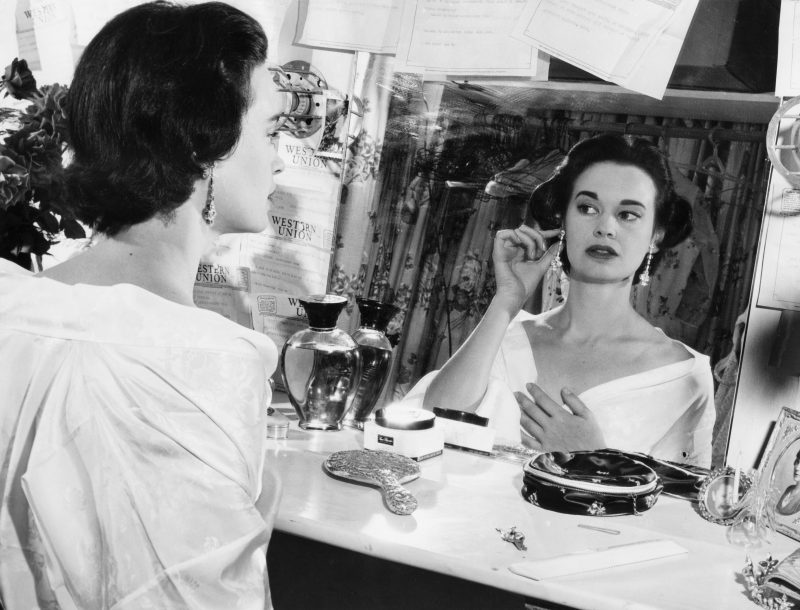Heiress and legendary socialite Gloria Vanderbilt dies at 95
Gloria Vanderbilt, pictured in 1954, was thrust into the spotlight as the “poor little rich girl” at the center of a sensational custody battle in the 1930s, before finding fame in her own right as a designer (-)
New York (AFP) – American heiress Gloria Vanderbilt, a designer and artist who became one of the most chronicled socialites of her era, died Monday after a battle with stomach cancer, her son announced. She was 95 years old.
The great-great granddaughter of railroad tycoon Cornelius Vanderbilt, she was thrust into the spotlight as the “poor little rich girl” at the center of a sensational custody battle in the 1930s, before finding fame in her own right for her line of designer blue jeans and it-girl fashion.
“Gloria Vanderbilt was an extraordinary woman, who loved life, and lived it on her own terms,” her son, the CNN anchor Anderson Cooper, said in a tribute read on air.
“She was a painter, a writer, and designer but also a remarkable mother, wife, and friend. She was 95 years old, but ask anyone close to her, and they’d tell you, she was the youngest person they knew, the coolest, and most modern.”
Artistic and glam, Vanderbilt was well-known for her tumultuous love life that included four marriages and racy escapades with a slew of suitors including Frank Sinatra, Gene Kelly and Marlon Brando.
“It is fantastic how Vanderbilt she looks! See the corners of her eyes, how they turn up?” her father, aristocrat Reginald Claypoole Vanderbilt, is said to have exclaimed after her birth in Manhattan on February 20, 1924.
Baby Gloria Laura Madeleine Sophie was left with a multi-million dollar trust fund after Reginald — the descendant of wealthy Dutch and English shipping and transportation barons — drank himself to death slightly more than a year later.
Her notoriously unstable mother — Gloria Laura Mercedes Morgan, who wielded the reins of the trust fund — swept Vanderbilt away to Paris to be raised by a nanny, while she became a mainstay of the party circuit with her twin sister.
But Vanderbilt’s philanthropist and artist aunt, Gertrude Vanderbilt Whitney — founder of New York’s famed Whitney Museum of American Art — sued for custody in 1934.
She won after a highly publicized trial that at moments heard the young girl weep and wail, and aired sordid testimony of greed and debauchery as most Americans suffered under the Great Depression.
– Feminine Renaissance Man –
Back stateside, Vanderbilt grew up pampered by servants, chauffeurs and tutors in her aunt’s mansions in New York and Long Island.
The socialite-in-waiting dabbled in art, modeling, poetry and acting in a bid to carve out an identity beyond her lavish inheritance. Eager to grow up quickly, she married for the first time at age 17, to a mob associate of the boss Charles “Lucky” Luciano.
“As a teenager she tried to avoid the spotlight, but reporters and cameramen followed her everywhere,” Cooper said. “She was determined to make something of her life, determined to make a name for herself, and find the love she so desperately needed.”
A regular of best-dressed lists and gossip columns, Vanderbilt’s A-list coterie included Charlie Chaplin and Truman Capote, who is said to have drawn inspiration from the lithe, raven-haired heiress for the iconic character Holly Golightly — played in the film version by Audrey Hepburn — of his 1958 novella “Breakfast at Tiffany’s.”
Her myriad artistic endeavors led Life magazine in 1968 to dub her “a feminine version of the Renaissance Man.”
She made fashion waves in the 1970s with a line of designer denim carrying her signature on the back pocket, which she modeled herself and promoted on tours nationwide.
Her brand expanded to include other apparel along with fragrances and linens, growing to a reported $100 million-a-year business.
“I’m not knocking inherited money,” she told The New York Times in 1985, “but the money I’ve made has a reality to me that inherited money doesn’t have.”
– ‘Big fat hopes’ –
After her first failed marriage she tied the knot three more times, first to the conductor Leopold Stokowski, with whom she had two sons, and then to director Sidney Lumet.
Her final marriage to Wyatt Emory Cooper in 1963 produced two more sons, Carter Vanderbilt Cooper and Anderson Hays Cooper.
She suffered major personal tragedy — her last husband died during heart surgery in 1978, and Vanderbilt endured the horror of losing one of her sons to suicide 10 years later.
The Vanderbilt family has said Carter had been troubled by depression and may have experienced a psychotic episode due to a medication he was taking.
The 23-year-old arose in the middle of the night, apparently confused, and leapt to his death, they said. Vanderbilt rarely spoke of the tragedy.
“Her private self, her real self was more fascinating and lovely than anything she showed the public,” Anderson Cooper said of his mother. “She trusted too freely, too completely and suffered tremendous losses, but she always pressed on, always worked hard, always believed the best was yet to come.”
She was open about her numerous love affairs with single and married men, which she detailed in a 2005 memoir. She also wrote poetry, short stories and novels — including erotica she penned in her 80s.
“You must always have great, secret, big fat hopes for yourself in love and in life,” Vanderbilt is known to have said. “The bigger, the better.”
Disclaimer: Validity of the above story is for 7 Days from original date of publishing. Source: AFP.


